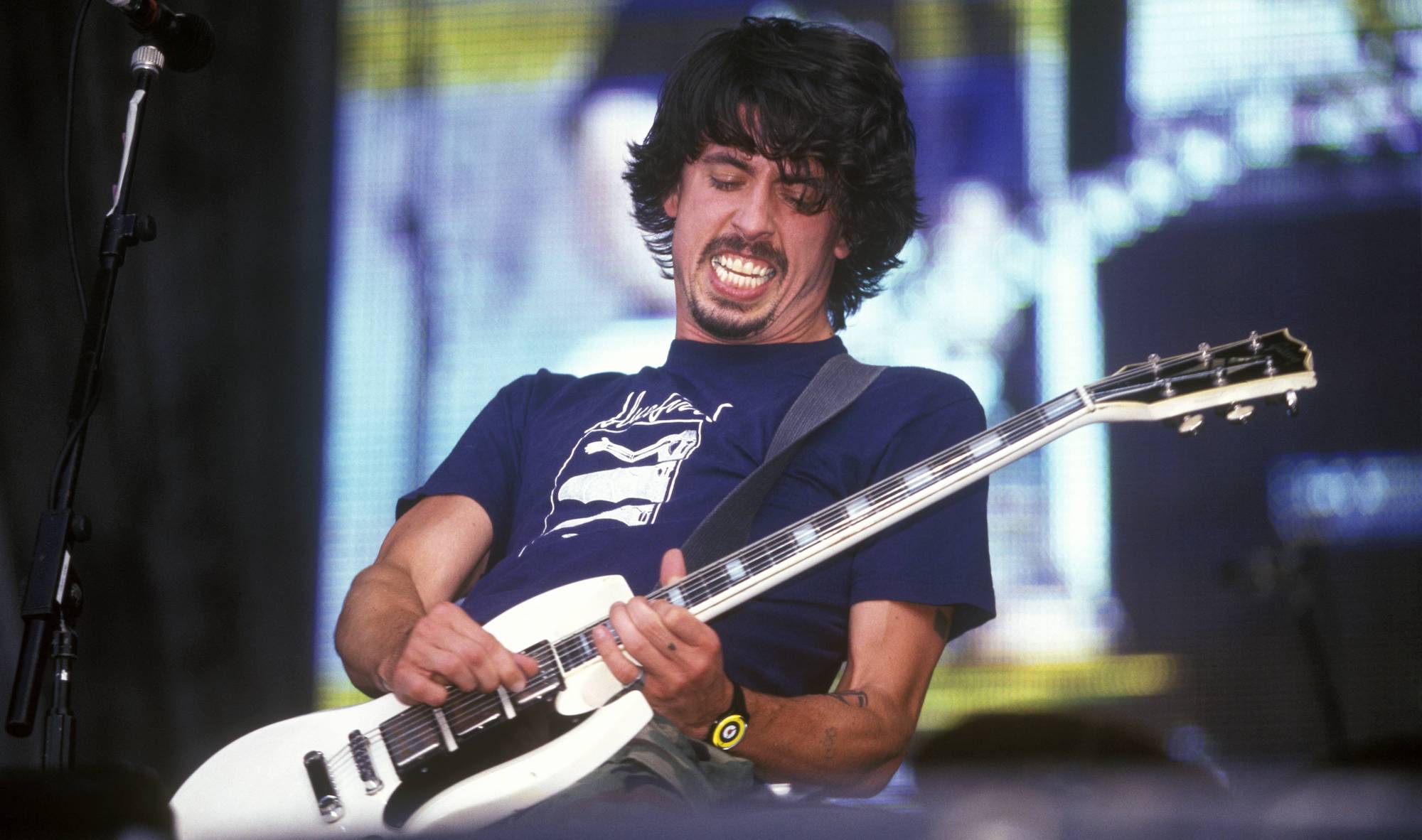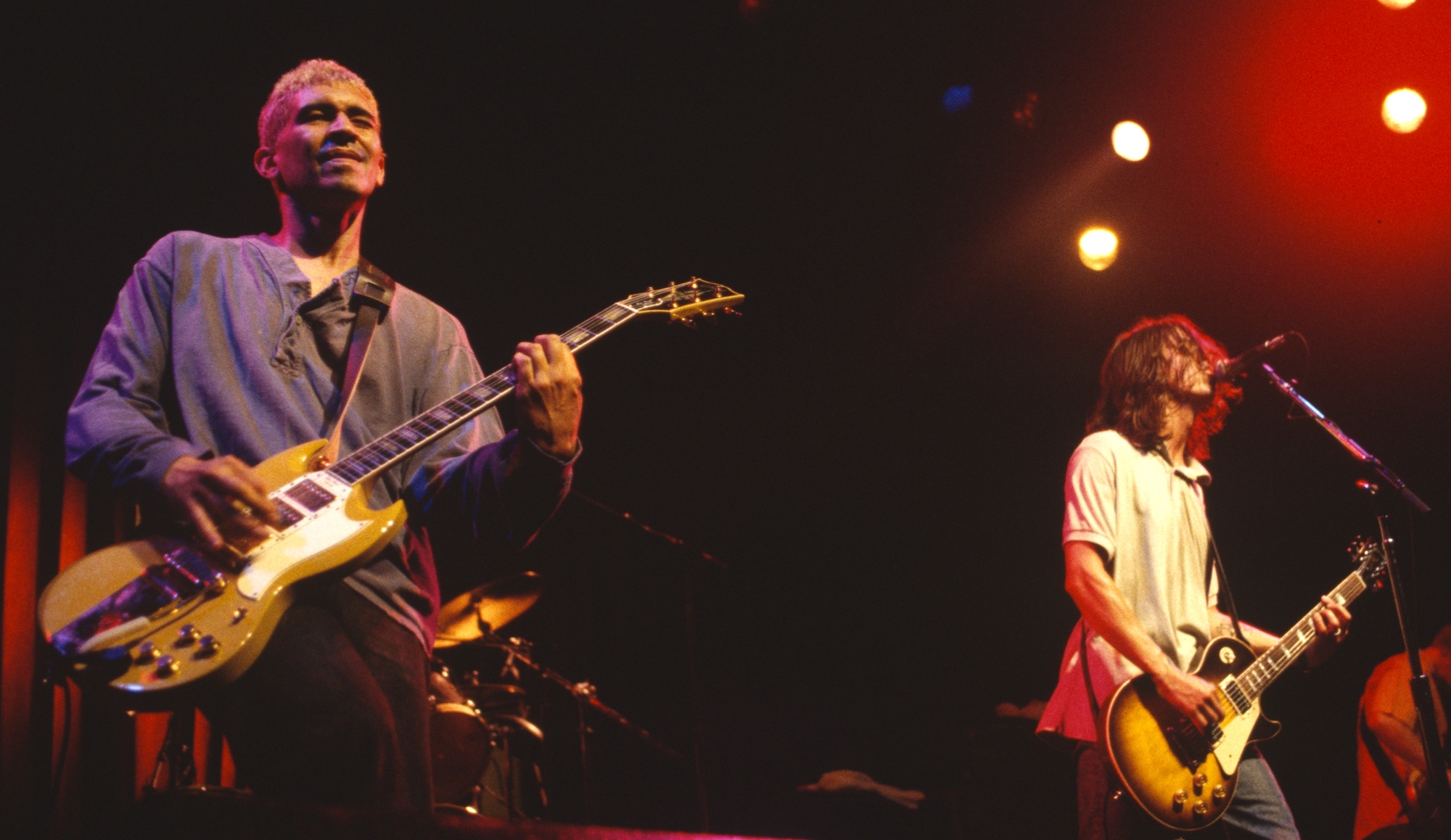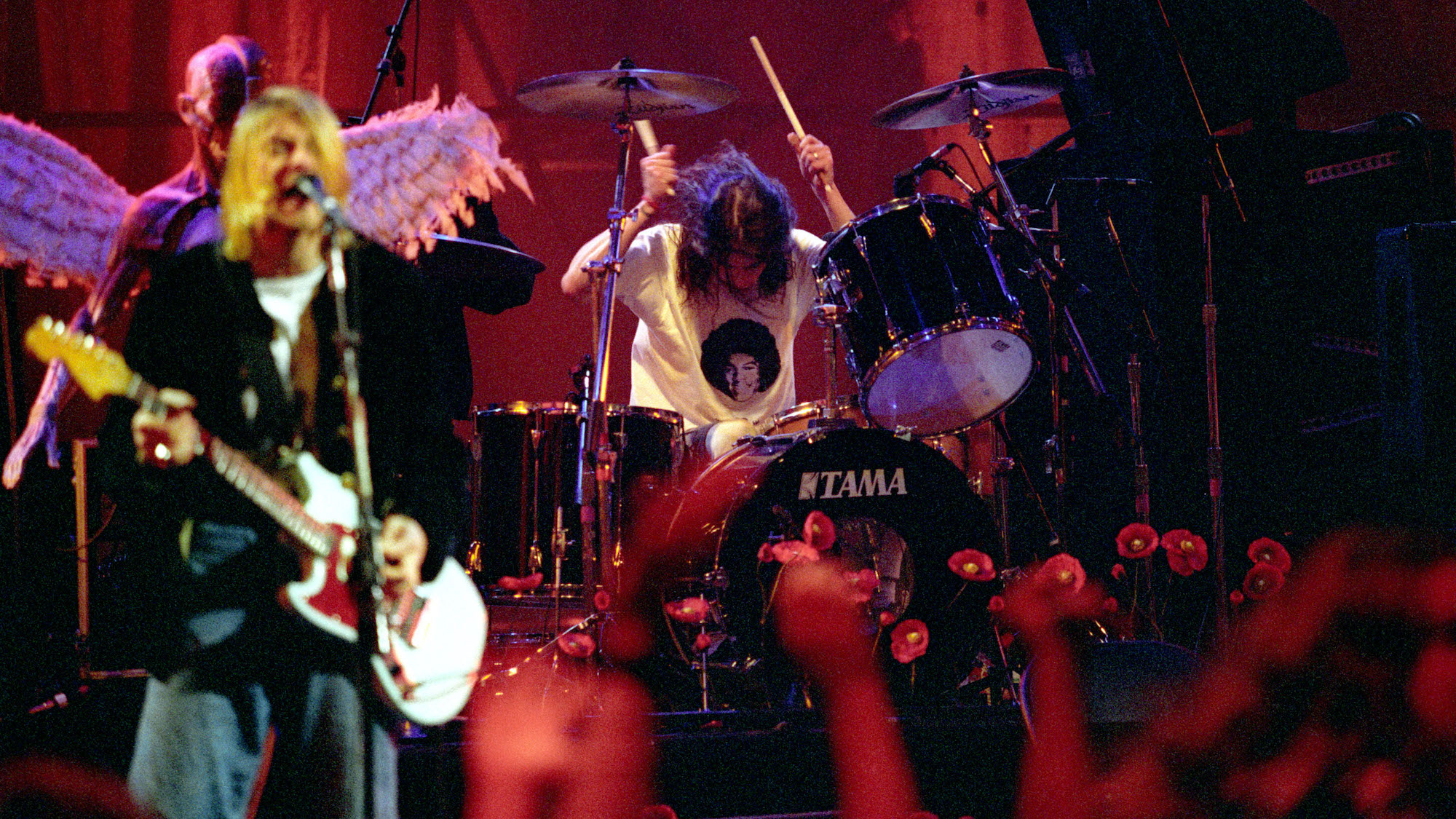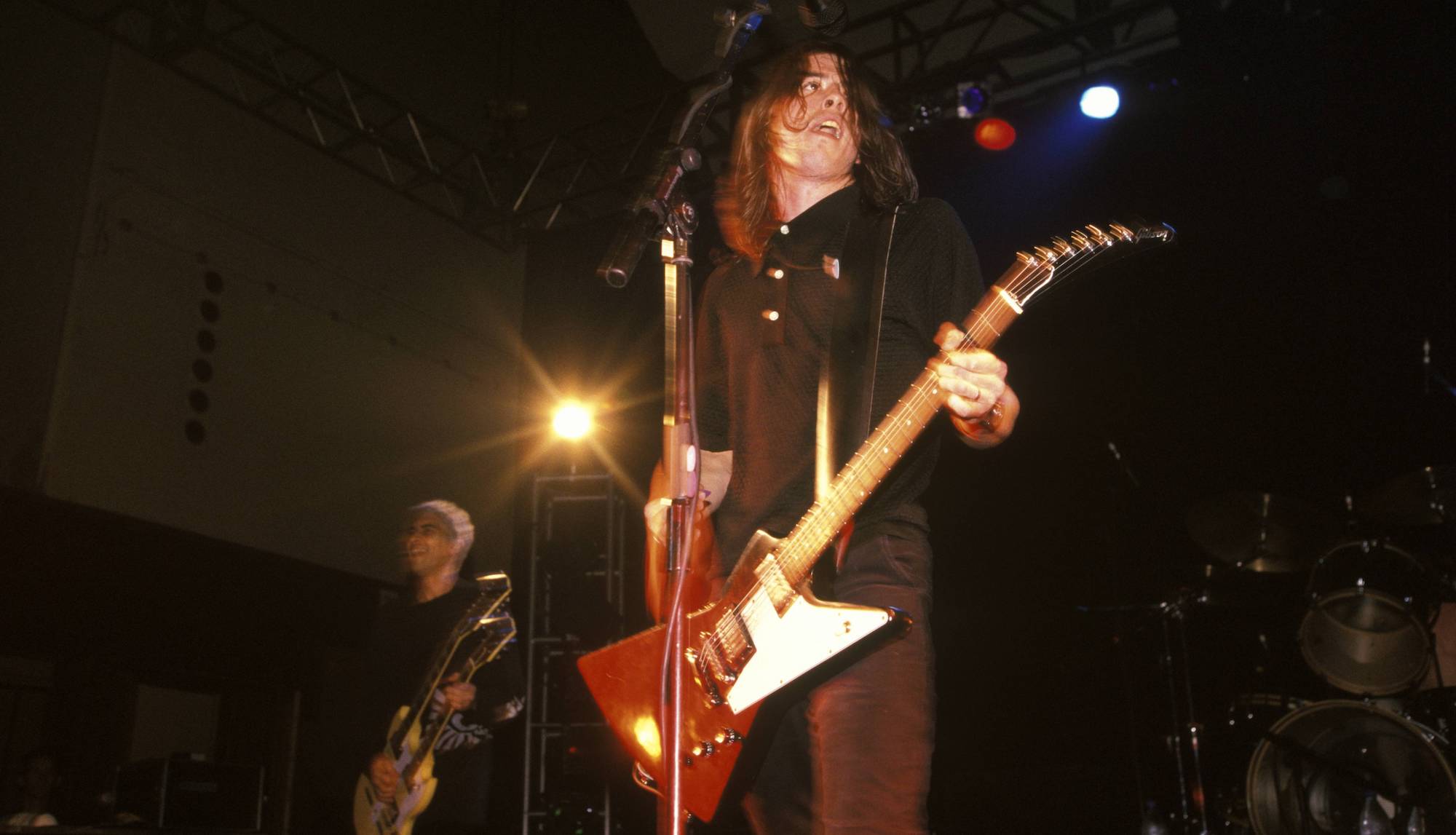Foo Fighters' Dave Grohl: "Through Kurt, I saw the beauty of minimalism and the importance of music that's stripped down. That's more powerful"
In this 1997 GW interview, Grohl discusses how Nirvana shaped his songwriting approach, the impact of Taylor Hawkins, and a then-new song of his called Everlong

The following interview with the Foo Fighters' Dave Grohl and Pat Smear was originally published in the August 1997 issue of Guitar World.
In the dank half-light of a North Hollywood rehearsal room, Pat Smear strokes his chin meditatively as he selects a guitar for the night's work ahead. Hmm, should he go with his opulent Gretsch White Falcon or his el cheapo Asian SG copy? Decisions, decisions.
Only a mind as unconventional as Smear's could hold the two instruments in equal esteem. Towering over his guitar rack in a pair of red plaid trousers that accentuate his tall, slim frame, Smear opts to go Gretsch this time.
A few paces away, Taylor Hawkins sits on the floor in front of his drum kit, shirtless and pale-skinned like some schoolboy gone savage in a scene from Lord of the Flies. The drummer, who'd been regaling his bandmates with an a cappella medley of tacky Eighties pop hits, pauses to belch resonantly. Wonder how his former bandleader, Alanis Morissette, would've enjoyed that? But it takes more than a rude noise to disrupt the guy world of the Foo Fighters.
Over in a corner, Nate Mendel fiddles with his bass rig, with the serene, astute air of a class nerd with his pet science project.
Suddenly, Dave Grohl bursts through the door. Just off the plane from Japan, the chief Foo is still running on crazy, jet lagged energy. Tall, lanky and sporting a full goatee these days, he bounds across the room and straps on a tobacco sunburst Les Paul. In an instant, the three other musicians are all focused and charged up, like their leader.
They launch into Everlong, a guitar-fueled, quintessential alt rock Nineties tune from the new Foo Fighters album, The Colour and the Shape. Grohl obligingly pauses to show me the chords: a series of barre shapes against an open sixth string tuned down to D.
Get The Pick Newsletter
All the latest guitar news, interviews, lessons, reviews, deals and more, direct to your inbox!
"I have no idea what these chords are called," he declares with punky aplomb. He sure can play `em, though. A multi-faceted talent, Grohl did the drumming that propelled Nirvana to Nineties rock supremacy. But he started out on guitar at age 10. Not long after, he was playing in Washington D.C.'s thriving mid-Eighties hardcore punk scene.
A personnel shift in his very first band, Freak Baby, led him to get behind a drum kit. He pummeled the skins for a variety of D.C. bands – Mission Impossible, Dain Bramage and Scream – before being asked out to Seattle to join Kurt Cobain and Krist Novoselic just in time to record Nirvana's landmark Nevermind.
But Grohl always kept his guitar handy, and eventually began writing songs on it. "When Nirvana was on tour, I'd bring a guitar with me," he says, "so in hotel rooms, late at night, I'd have something to do. I love playing the drums, but you can't really sit down at home with a snack and play the drums. So I've never been without a guitar. Eventually, I was living with a person who had an 8-track in the basement. And these songs just started coming out."
Those songs eventually formed the basis for the first Foo Fighters album. Recovering from his initial shock and grief at the death of Kurt Cobain and the end of Nirvana, Grohl went in the studio and recorded Foo Fighters almost entirely on his own. But somewhere between the tracking and the mixing of the record, the Foo Fighters went from being an imaginary band to a real one.
Grohl didn't have to look far for a co-guitarist. Pat Smear had played with Nirvana during the band's final phase. A punk rock originator, he'd played guitar with the legendary Germs, which made him a rock and roll hero to both Cobain and Grohl.

Nate Mendel and drummer William Goldsmith – who had played with Sunny Day Real Estate and whom Grohl knew from around the Seattle scene – became the Foo Fighters' rhythm section. Goldsmith dropped out of the band during sessions for The Colour and the Shape, leaving Grohl to finish up the drums on the record. Shortly after the disc was completed, Morrisette alumnus Taylor Hawkins was recruited as the Foo Fighters' new drummer.
"I just have so much faith in those guys," says Grohl of his bandmates. "If I come in with the most ridiculous three chord, verse/chorus/verse idea, I know they can make it into something great. Without them, this album would have sounded thinner and less interesting. That's why I'm so proud of it. Everybody threw in their two cents and it came out as this big sound."
What's your take on the current state of rock, post-grunge, late Nineties? There's no single reigning style right now, which allows all kinds of sounds to come through.
Dave Grohl: "Yeah, it's kinda nice. Hopefully, eventually, the whole brooding, Fender Jaguar grunge style will go away. It isn't gone yet. It will be soon, though. And it'll be time for some good old Les Paul, southern rock." [laughs]
The Foo Fighters have always maintained a balance of pop melodicism and harder, "grunge" elements. Is that just a natural combination of things for you, or a very carefully worked out mixture?
"We all love music, whether it's the Beatles or Queen or punk rock. I think the lure of punk rock was the energy and immediacy; the need to thrash stuff around. But at the same time, we're all suckers for a beautiful melody, you know? So it is just natural. I loved the Beatles when I was a kid, but I loved the Bad Brains too. And there were a lot of bands in the early to mid Eighties that were a perfect blend of those things.
"Hüsker Dü had a searing guitar sound and breakneck speeds, but they'd do that as they were covering the Byrds' Eight Miles High. It was just beautiful and powerful. I think that's probably where it all comes from. It's not necessarily blueprinted or calculated. It's just the way we like to play."
Pat Smear: "Punk was the first music I played in a band. But it wasn't the first music I was into. I was into Queen, Bowie and Alice Cooper – that Seventies pop/rock/glam kind of thing."
Dave, was Kurt Cobain was a big influence on you as a songwriter?
"Kurt was definitely a big influence and inspiration. When I first moved up to Washington state, I lived with Kurt in this tiny apartment. For the longest time, we didn't have a television. We didn't have anything to do. So we'd spend these gray Olympia, Washington, afternoons just playing guitars and messing around with a 4-track, or working on harmonies.
"Through Kurt, I saw the beauty of minimalism and the importance of music that's stripped down. That's more powerful, because it's just so... almost desperate."
A sense of stark contrasts is one common element between Nirvana and the Foo Fighters. Sweet verses that give way to abrasive choruses, the whole loud/soft dynamic that set the blueprint for Nineties alternative rock – where did all that come from?
"From Kurt, Krist and I liking the Knack, Bay City Rollers, Beatles and Abba just as much as we liked Flipper and Black Flag, I suppose. The dynamics thing specifically came out of this four-month period before Nevermind was recorded, where we were rehearsing maybe five days a week for three or four hours a day, just writing songs and jams and stuff like that. And we just started experimenting with these really extreme dynamics.
"It's not like we were the first band to do it. You listen to any Pixies record and it's all over there. Or even Black Sabbath's War Pigs – it's there: the power of the dynamic. We just sort of abused it with pop songs and got sick with it – silly with it. It was fun: feeling good in some mellow verse and then smashing your way into some big, huge, distorted chorus. I suppose it's a cheap way to make the chorus seem a lot bigger than it really is."
You joined Nirvana kind of "in progress," Dave. Kurt and Krist started it.
"Yeah, I was their seventh drummer."

So did you really feel fully a part of where they were coming from?
"Where they were coming from, yeah. But I always felt kind of expendable. When you're the seventh drummer, it would be pretty big-headed of you to imagine yourself being the final drummer."
Was that a factor in your always writing songs on your own – why you had a musical life and identity apart from Nirvana?
"Not really. When you're in a band with somebody like Kurt, who was an amazing songwriter, you do anything you can to keep from polluting the songwriting process. I thought, 'I don't want to be the person responsible for ruining these songs.' There's a famous old joke: What was the last thing the drummer said before they kicked him out of the band? 'Hey guys, I got a new song I just wrote.' Why fix it, if it ain't busted?
"I was in awe of what was happening. I was in awe of Kurt's songs. And intimidated. I felt it was best that I keep my songs to myself."
You didn't play them for anyone?
"Yeah. I was always really freaked out about singing and my voice. I still am, kind of. But every once in a while I'd play a tape for a friend and try to have them guess who it was. They'd be like, 'Is this the new Sloan record? Who is this?' 'No, it's me.' There are probably seven or eight people in the world that heard any of this stuff before the album came out. It was really just because I was embarrassed and shy.
"When you play big loud drums in a rock band five days a week, hitting them as hard as you can, when it comes to something as delicate as an acoustic melody, it's a little scary. You're really putting yourself on the line."
Would you two say your approach to guitar playing is similar?
Smear: "It seems like our intentions are a lot different when we play, but in the end it comes out pretty much the same. The only way you'd be able to know isn't by our songs but when we're just fucking around in the studio. Dave can actually pull off the rock leads and stuff like that."
Grohl: "Pat's nuts. You think of Pat as being the punkest of the punk, but he taught me how to play Blackbird. [laughs] It's really hard. He's a great guitar player."
So, when you're coming up with guitar arrangements you don't really see it as a lead/rhythm thing?
Smear: "I'm all about rhythm. I'm anti-lead. I've been in bands before where I had to pay lead. I've had enough of that. Rhythm guitar players get no respect."
Grohl: "I think there's maybe only one lead on the record. I don't really know how to do leads. I think if a song doesn't need a solo, then why put one in? I've got nothing to show off, that's for sure."
Do drummers tend to be intimidated by working in a band with you?
Grohl: "Yeah, for whatever reason, I don't know. I'm so incredibly overrated as a drummer. I'm just a minimalist drummer. I am. I swear. I'm not there to do anything but propel the song."
But you do it in a way that no one else does.
"I dunno. Since Taylor's in the band, I don't even get behind the drum set `cause he makes me feel like a fool. I watch him do all this crazy stuff, then I sit down and do an AC/DC beat! He's so far out of my league, it isn't funny. Being a guitar player who's also a drummer, I understand the relationship between the two instruments. And Taylor is a drummer who's also a guitar player, so he understands it too. So there's not much I really need to explain to him.
"People who understand song structures and riffs don't have much trouble feeling their way through a song. They can just sense when things need to come down, when things need to repeat, and when there needs to be an accent."

There's such a thing as rhythmic intelligence.
"Yeah, look at someone like J Mascis, who is an amazing drummer and a wailing guitar player too. He understands the relationship between the two. Look at Prince – same thing."
All those guys understand the rhythmic potential of the guitar.
"I wonder if James Hetfield knows how to play the drums. Because, basically, he's taking care of the percussion and the melody of Metallica's songs with his guitar."
That chunking.
"Yeah. And it's great. There's the relationship right there."
In a career that spans five decades, Alan di Perna has written for pretty much every magazine in the world with the word “guitar” in its title, as well as other prestigious outlets such as Rolling Stone, Billboard, Creem, Player, Classic Rock, Musician, Future Music, Keyboard, grammy.com and reverb.com. He is author of Guitar Masters: Intimate Portraits, Green Day: The Ultimate Unauthorized History and co-author of Play It Loud: An Epic History of the Sound Style and Revolution of the Electric Guitar. The latter became the inspiration for the Metropolitan Museum of Art/Rock and Roll Hall of Fame exhibition “Play It Loud: Instruments of Rock and Roll.” As a professional guitarist/keyboardist/multi-instrumentalist, Alan has worked with recording artists Brianna Lea Pruett, Fawn Wood, Brenda McMorrow, Sat Kartar and Shox Lumania.
“For years, the only 12-string acoustics I got my hands on, the necks always pulled off after a bit. I earned a lot of money replacing them!” Why one of the UK’s most prolific luthiers is a bolt-on acoustic die-hard
“It holds its own purely as a playable guitar. It’s really cool for the traveling musician – you can bring it on a flight and it fits beneath the seat”: Why Steve Stevens put his name to a foldable guitar














